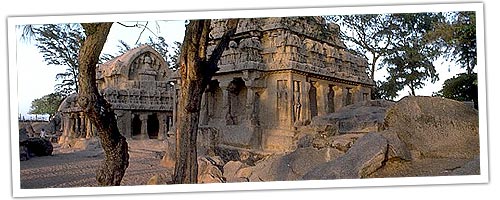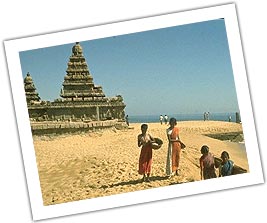South India is the most important and progressive part of India. In the
field of IT industries, Bussiness and Technologies, scientific Research
centers and others this regions is quite farward than any other. South India
Vaction Packages explore the south Indian culture and heritage, its ritual
and customs, and above all its beautiful landmarks and its urban and rural
life.
Day 1 Arrive - Chennai
On arrival in Chennai, check in at the hotel booked for you.
Chennai, widely known as Madras till 1996, has a rich tradition and civilisation
with a blend of the old, and the new, vibrating ceaselessly to keep pace
with the rest of India, as the buoyant metropolis of the third most industrialised
State. Chennai is the fourth largest city in India and the capital of Tamil
Nadu. Retaining much of its traditional charm, this 350 year old city is
the gateway to the south, providing many a fascinating vignette of southern
heritage.
Rest of the evening at leisure. Overnight at the hotel
dd

Day 2 In Chennai Today the day will be at leisure to enjoy some of
the tourist places in Chennai
Some of the sightseeing options are:
Visit the famous Marina Beach, The National Art Gallery, BM Birla
Planitarium, The Snake Park, St Mary's Church, and the Kapaleeswarar Shiva
temple (biggest Temple in Chennai)Return to the hotel in the evening.
Overnight at the hotel in Chennai
Day 3 Chennai -
Mamallapuram ( approx 60 kms ) This morning after breakfast proceed
to Mamallapuram by surface On Arrive check-in at the hotel / Resort booked
for you
Mamallapuram, located about 60km south of Chennai on the
Bay of Bengal, means "the town of Mamalla, the great wrestler."
Mamalla is the title given to the Pallava ruler Narasimha Varman I, who
built many of the temples here. The previous name Mahabalipuram means "the
town of the great king Bali," from whom Lord Vamana (Vishnu) begged
three paces of land. This town was an ancient port of the Pallavas kings,
who ruled from Kanchipuram from the 4th to the 8th centuries. It is believed
that most of the carvings were done under the patronage of the Pallavas
kings, Narasimha Varma I (630-668 AD) and Narasimha Varman II (700-728). The
temples here are among the earliest examples of monumental architecture in
South India. They were made mostly between the 5th and 8th centuries. Most
of the cave temples are carved out of a granite hill that is close to the
sea.
Late afternoon proceed for sightseeing.
Sightseeing
options: Visit the Cave Temples, Rathas, Arjuna's penance, Shore Temple,
Kanchipuram,Vedanthangal Covelong and the Crocodile Bank (The main
attraction at the Crocodile Bank is the crocodile conservation center, which
is the largest croc-breeding site in India.)
Overnight at the hotel /
Resort in Mahabalipuram.
Day 4 Mamallapuram -
Pondicherry ( approx 100 kms ) This morning depart for Pondicherry
by surface. On arrival check into the hotel booked for you.
Founded by
the French, Pondicherry is generally known as the seat of the famous
Aurobindo Ashram. Its spiritual aura transcends the tourism potential of the
city. The township of Pondicherry is planned on a grid system, which is to
say that the roads meet each other at right angles. On the seaward side is
the long Petit Canal which divides the town so that the French township is
on the side facing the sea and the predominantly Indian/Tamil one on the
other.
Late afternoon visit Sri Aurobindo's Ashram and Auroville.
Overnight at the Hotel / resort in Pondicherry
Day 5 In Pondicherry Today continue with the sightseeing of
Pondicherry, or go for shopping. Walk along the sapphire waters of the long
beach (Swimming is generally not advised but you can get a joy ride in a
catamaran in the backwaters of the Bay of Bengal )
Nehru Street is
a paradise for a shopper where one can buy leather and pottery goods.
Besides, a lot of gift items like bags, bed sheets, paper lanterns and
trendy T-shirts can be bought.
Also visit the Botanical Gardens.
Return to the hotel in the evening. Overnight in Pondicherry
Day 6 Pondicherry - Tanjore ( approx 170 kms ) Morning depart for
Tanjore by surface. Arrive Tanjore. Check-in at the hotel.

Tanjore
or Thanjavur, as it was called earlier, as the capital of the Chola empire
from the 10th century to the 14th century AD, later became part of the
Vijaynagar Kingdom, then passed into the hands of the Marathas and later
still went to the British Thanjavur is well know for its traditional
handicrafts and classical Indian musical instruments.
Late
afternoon, proceed for sightseeing visiting Brihadeshwara Temple, Thanjavur
Palace adjacent to the temple, the Saraswati Mahal Library and the art
gallery that houses a superb collection of bronze statues from 9th to the
12th centuries
Overnight at the hotel in Tanjore.
Day 7 Tanjore - Madurai ( approx 160 kms ) This morning check out
of the hotel and depart for Madurai. On arrival check in at the hotel booked
for you Madurai is called Athens of the East because of the way myth meets
life here. Originally called Madhurapuram because honey (madhu) is said to
have dripped off the locks of Shiva here. Madurai was an important cultural
and commercial centre even as early as 550 AD. Madurai was the capital city
of the great Pandya kings. This sacred town attracts thousands of pilgrims
and visitors from India and abroad.
In the evening visit the famous
Meenakshi Temple. You can also participate in an evening Aarti.
Overnight at Hotel in Madurai.
Day 8 Madurai -
Rameshwaram - Madurai The day will be at leisure. You may continue
the sightseeing in Madurai to include
The Thirumalai Nayak Palace the
Gandhi Museum and the Mariamman Teppakulam. Or do an excursion to
Rameshwaram.
Rameshwaram is an island situated in the gulf of
manner at the very tip of the Indian peninsula. A very important pilgrim
centre of the Indians. Rameshwaram is the place from where Lord Rama, built
a bridge across the sea to rescue his consort Sita, from her abductor,
Ravana. This is also the place where Rama worshipped Lord Shiva to cleanse
away the sin of killing Ravana. Both the Vaishnavites and Shaivites visit
this pilgrimage which is known as the Varanasi the south.
Rameshwaram is significant for the Hindus as a pilgrimage to Benaras is
incomplete without a Pilgrimage to Rameshwaram. The presiding deity is the
Linga Of Sri Ranganatha, which happens to be one of the twelve Jyotirlingas
of India. Rameshwaram is also popularly referred to as the 'Benaras of the
south'. In order to attain Moksha it is believed that the visit to
Rameshwaram is mandatory.
Return to Madurai in the evening.
Overnight at Hotel in Madurai
Day 9 Depart
Madurai This morning check out of the hotel and proceed to the
Madurai airport to board your flight for your onward destination


 Tanjore
or Thanjavur, as it was called earlier, as the capital of the Chola empire
from the 10th century to the 14th century AD, later became part of the
Vijaynagar Kingdom, then passed into the hands of the Marathas and later
still went to the British Thanjavur is well know for its traditional
handicrafts and classical Indian musical instruments.
Tanjore
or Thanjavur, as it was called earlier, as the capital of the Chola empire
from the 10th century to the 14th century AD, later became part of the
Vijaynagar Kingdom, then passed into the hands of the Marathas and later
still went to the British Thanjavur is well know for its traditional
handicrafts and classical Indian musical instruments. 